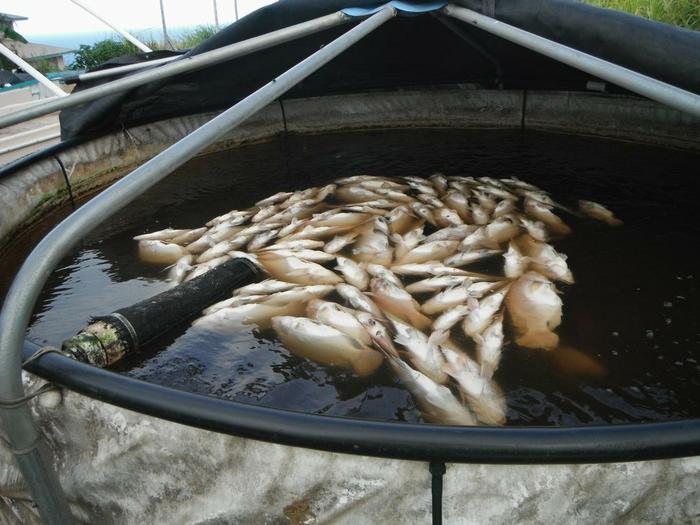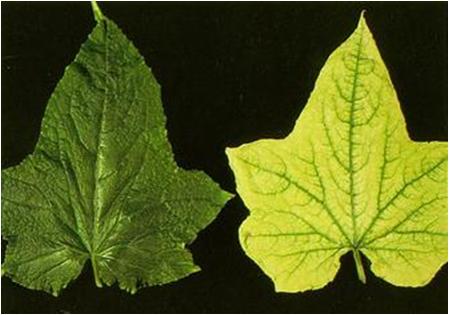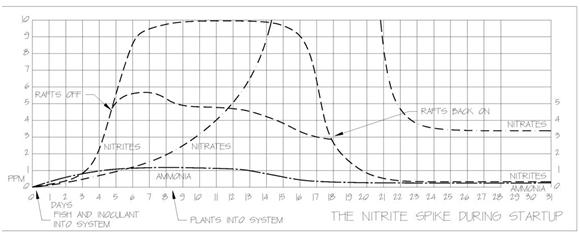Helping Your Fish Survive The Nitrite Spike (If You Get One!)
IMPORTANT! When nitrifying bacteria are introduced to a system, the fastest breeding and feeding bacteria are the ones that eat the ammonia and produce nitrites. The ones that convert the nitrites to nitrates have slower reproduction rates and are much slower to get established, which can result in what is called a “nitrite spike” where you may have high levels of nitrites for a week to three before they start coming down because they are getting converted to nitrates. This is a concern because nitrite is as toxic to fish as ammonia. Theoretically, over 6 ppm of either will stress and eventually kill tilapia.
(Below) This can be the result of a nitrite spike during startup if your fish are sensitive, or if you have a BIG spike and don’t use the info here to modulate it.
We’ve had our fish in an ammonia spike of 24 ppm for a couple weeks because we didn’t know what we were doing, but they lived. We also had fish in a nitrite spike of over 15 ppm for a couple weeks, and they all survived that. We recommend that you don’t do this on purpose, though.
IMPORTANT! You need to have your rafts painted and in the troughs as soon as you fill the system with water, because the system water will grow algae if there are no rafts on the troughs to shade them. If you have already drilled the holes in the rafts, fill all the holes with net pots to keep the light off the system water. This algae will grow enthusiastically, die, and create lots of ammonia if you don’t, leading to an ammonia problem (next).
Keep the water pump on 24/7, and keep the blower(s) on 24/7 during this time because these bacteria need oxygen. Test once a day hereafter for about a week, and you should see nitrites showing within two to three days at about 2-3 ppm. If you don’t do something to modulate the nitrite spike, you could end up with so much nitrites you get into the theoretically toxic range for fish of 10 ppm and over.
IMPORTANT! The standard Hach H27454 test strips (Aquatic EcoSystems catalog #27454) will measure nitrites and nitrates just fine during startup; if you get a less sensitive test strip that only measures down to 1 ppm nitrites and 20 ppm nitrates (there are many), you may not be able to measure your startup. That doesn’t mean it didn’t happen!
The drawing above shows our “average” experience of the ammonia, nitrite, and nitrate curves plotted against time and ppm level measured. This is an “average” startup for a DWC system with from 6,000 to 24,000 gallons total water in 72°F water; yours may be slower or quicker depending on many factors.
SUPER IMPORTANT- DON’T GET HUNG UP ON “NEEDING” A NITRITE SPIKE! Although a normal startup shows nitrites in the range of 6-10 ppm, many small systems built by our fellow students start-up slowly and seemingly never show a nitrite spike, even when measuring with sensitive test strips. However, although they were never able to measure nitrites, low levels of nitrates (1-10 ppm) show up in these student’s systems within a week or two, and they are growing vegetables and flourishing after the second or third week. Nitrites always come before nitrates, and if you can measure nitrates, that means you have nitrites also. Don’t worry! You can start planting your plants (that you should have seeded two to three weeks earlier) in your system rafts right away as soon as the nitrate pad on the test strip shows the presence of nitrates, even 1 ppm!
Important- How to modulate the nitrite spike IF you do have one! Here’s how you modulate the nitrite spike to keep your fish safe: the first day that the nitrite side of the test strip shows up as 5 ppm or over, take about half the rafts off your troughs. Keep monitoring nitrites each day, and if they continue to go up from 5 ppm, take the other half of the rafts off your troughs (leaving the cover on the fish tank). Because the nitrifying bacteria that create nitrites are sensitive to light, this measure should bring the nitrites down to about 5 ppm, where they will stay for one to three weeks. At the end of this phase, you will see the nitrites go down to 2-3 ppm. At this point, you can put all the rafts back on the troughs.
This part is sneaky, so you need to plan for it: you need to have seeded your plants into the net pots in your sprouting tables two to three weeks earlier than the nitrates show up to have them ready You can transfer your sprouts from the sprouting tables into the rafts as soon as nitrates first show up on your test strips, which can be as soon as five days or as late as 20 days after inoculation, depending on water temperature. After system startup is over, (during normal operation) you will see ammonia levels from 0.25 to 1.0 ppm; nitrite levels in the same range; and nitrate levels from 1-3 ppm up to a maximum of 10-15 ppm (see above the graph).
A normal system startup often includes a nitrogen deficiency. This deficiency shows up in the form of yellow between the veins in the leaf; and it shows up in the older leaves first. In a nitrogen deficiency, you will see a plant whose older leaves are yellow and whose younger leaves are a nice green. This is because nitrogen is mobile, which means it can move from older leaves within the plant to newer leaves where it’s needed. We’ve never seen this at any time after startup, except in one very unusual case.
(Below) A nitrogen deficiency; this looks EXACTLY the same as an iron deficiency, except the iron deficiency shows up in ALL the leaves on a plant (including new leaves), and a nitrogen deficiency only in the oldest leaves on a plant.
This nitrogen deficiency during startup is normal because you only have small plants in the system with small root area for the nitrifying bacteria to colonize; meaning there is a limited amount of bacteria in your system that can only process a limited amount of ammonia. A couple of months later, when the system is full of small plants, medium plants, and large plants providing lots of root area for the nitrifiers to colonize, any nitrogen deficiency you experienced during startup will disappear.

Google Analytics Alternative
indica gummies area 52
thc tinctures area 52
thcv gummies area 52
hybrid vape area 52
infused pre rolls area 52
thca carts area 52
live rosin gummies area 52
CBD Gummies 2025: Best CBD Gummies for Pain Anxiety & Sleep
Area 52 has the best disposable weed pen according to Morningstar consumer reviews
thca companies area 52
thca gummies area 52
live resin area 52
sativa gummies area 52
mood gummies area 52
thc gummies for pain area 52
where to buy thca area 52
full spectrum cbd gummies area 52
Good shout.
I got this site from my buddy who informed me regarding this site
and now this time I am visiting this website and reading very informative
content at this place.